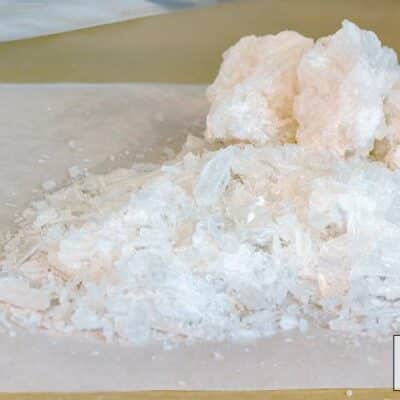What is Methamphetamine?
Methamphetamine is a highly addictive and powerful stimulant that impacts the central nervous system. Known by its street names like crystal and ice, this drug is a bitter-tasting, odorless, white crystalline powder that is water and alcohol soluble. Developed from amphetamines in the early 20th century, this drug used in bronchial inhalers and nasal decongestants.
Though both drugs act as stimulants, Methamphetamine is more potent as its adverse effects are longer-lasting and greatly affect the user’s brain. Methamphetamine is a controlled substance in the United States. However, it can legally obtained through a non-refillable prescription. The drug, in far lower doses taken by abusers, has been specified for the treatment of attention deficit disorder (ADHD) and in weight-loss treatments.
Screening Cut-Off and Detection Time
The cut-off level in drug screening the point where negative and positive test results separated. This screening cut-off level determined to establish that point where the detection of the drug far from false positives readings. An initial negative reading does not essentially mean that the sample is drug-free, but that the concentration level of drug in the sample is below the cut-off level. The initial screening cut-off level for Methamphetamine is 100ng/ml. Detection time for single use is up to 48 hours, and for long-term use is from 7 to 10 days. If the initial test is positive, a confirmation test required. The cut-off level for meth is at this point 500ng/ml.
Methamphetamine Drug Classification
The Drug Enforcement Administration adheres to the United States Code (USC) Controlled Substance Act. Under this code five schedules of controlled substances labeled as schedules I, II, III, IV, and V. The schedule of drug classification is based on the medical applications, safety, and abuse potential of the drug. Methamphetamine falls under Schedule II, which are drugs and substances that have a high potential for abuse; are currently acceptable in the United States for medical use with severe restrictions; and abuse of which may lead to severe physical or psychological dependence.

What Kind of Drug is Methamphetamine?
Methamphetamine is a powerful stimulant that targets the central nervous system. Its chemical breakdown is C 10 H 15 N and affects chemicals in the nerves and brain that influence impulse and hyperactivity control. This drug type increases energy, alertness, and attention, as well as elevated heart rate, blood pressure, and respiration. Methamphetamine increases energy, alertness, and attention, as well as elevated heart rate, blood pressure, and respiration.
Forms and Routes of Administration
Methamphetamine comes in various forms and can taken orally, injected, snorted, or smoked. The “high” experienced by the user depends on how the drug was taken. Methamphetamine Forms and Routes of Administration includes tablet form, powder form, crystal form, and yaba. Tablet Form – Methamphetamine Hydrochloride or the brand Desoxyn taken orally. This a medically prescribed drug for the treatment of ADHD and obesity. When orally ingested, the effect felt after 10-12 minutes. Powder Form – “Crank” refers to fine, coarse or chunks of meth powder. This yellow or off-white powder is supplied loose and wrapped in foil or a plastic bag, or in capsules.
When snorted, the effect felt in less than 5 minutes. Crystal Form – This type of meth resembles frozen water, thus the term “ice”. This crystallized meth can smoked in a glass pipe. The odorless smoke leaves a residue that can re-smoked. The effect may last up to 12 hours. Yaba – This is a combination of meth and caffeine made available in multi-colored and multi-shaped tablets that taste like grape, vanilla, or orange, much like candies. Yaba tablets are highly popular in rave and techno parties. Some choose to snort Yaba by placing it on aluminum foil and heating it.
Methamphetamine Brand Name
- Desoxyn
- Desoxyn Gradumet
- Methamphetamine Medical Use
This drug type has used to treat respiratory problems, asthma, neurological disorders, obesity, and other diseases. As its potential for abuse and dependence became evident, the medical use of methamphetamine has strictly limited to the treatment of ADHD, depression, and narcolepsy. Methamphetamine changes the number of particular substances in the brain in treating ADHD. It helps increase one’s ability to stay focused and pay attention to an activity, improve the capacity to listen and organize tasks. Doctors have prescribed this medication to help obese people lose weight as it decreases a person’s appetite.

However, drug use must for a short time in patients who are on a reduced-calorie diet, and who have not significantly lost weight with other treatments. Methamphetamine is not to used to treat fatigue or to keep people without sleep disorder from falling asleep.
Special Conditions
Methamphetamine must only taken under the direction of a qualified medical doctor. People who used MAO inhibitors such as tranylcypromine, selegiline, phenelzine, rasagiline, linezolid, and isocarboxazid, in the last 14 days must not use methamphetamine. Those who have allergic reactions to stimulant medicine must not take this drug. Those who have the following medical conditions not supposed to take this drug: Coronary artery disease or heart disease High blood pressure Overactive thyroid Severe agitation, tension or anxiety Glaucoma
History of drug addiction
People must inform their doctor if they have the above-mentioned conditions. If the patient’s family has a history of the following conditions, informing their doctors is a must: Mental illness, depression, psychosis, bipolar disorder, suicidal actions/thoughts Tourette’s syndrome or muscle twitches History of epilepsy or seizures Diabetes Brain wave abnormalities (EEG) Blood circulation problems in extremities Children, pregnant and lactating women must not take methamphetamine.
Children below 6 years old are not approved to take methamphetamine. Children under 12 years old are not approved to take this drug to treat obesity. There is no research or study that supports the theory that taking meth during pregnancy will harm the unborn baby. However, doing so can cause not only premature birth and low birth weight but withdrawal symptoms in the newborn baby. Methamphetamine or any other drug can pass into breast milk, thus harming the nursing baby.
Street Names for Methamphetamines
- Black Beauties
- Bikers Coffee
- Chicken Feed
- Chalk
- Crystal Meth
- Crack
- Ice
- Go-Fast
- Glass
- Methlies Quick
- Meth
- Poor Man’s Cocaine
- Quartz
- Snot
- Shabu
- Stove Top
- Speed
- Trash
- Tweak
- Upper
- Yellow Bam
- Yaba
Methamphetamines Side Effects
Methamphetamine is a potent stimulant that even if taken in small doses can increase one’s physical activity, wakefulness and decrease appetite. Meth can also cause a range of cardiovascular ailments such as increased blood pressure, rapid heart rate, and irregular heartbeat.
Symptoms of Use and Abuse
Traces of methamphetamine may indicated if one finds a small pouch of white crystals or powder with syringes. Some meth abusers may leave behind small, crumpled pieces of aluminum foil, small shafts or empty ballpoint pens that could used for snorting, or soda can punch with a hole at the side. Meth users or abusers:
> Do not or cannot sleep for long periods > Loss of appetite so they do not eat > Lose a lot of weight > May show signs of being unusually active; fidgets > Seems to be anxious and nervous > Coming down or “crash” after use can be unpleasant for the user. To avoid this crash, most go for a meth “run” wherein they take another dose of meth for continuous high. This could lead to serious or even fatal results.
Short-Term Effects of Methamphetamines
Dry Mouth Dilation of the Pupils Feelings of Power Irritability Palpitations Arrhythmias Tachycardia May Be Life-Threatening Feelings of Happiness Nervousness Restlessness Long-Term Effects of Methamphetamines Anorexia Nervosa Aggression Auditory & Visual Hallucinations Convulsions Death Drug Dependency Erratic Behavior Emotional Instability Exhaustion HIV/AIDS & Hepatitis (Injecting the Drug) High Blood Pressure Increased Body Temperature Increased Heat Rate Heart Attack Death Insomnia.
May Cause Lasting Brain Damage Mood Disturbances Nightmares Paranoia Picking at the Skin Preoccupation with One’s Own Thoughts Psychosis Akin to Schizophrenia Sadness & Unhappiness Sever Dental Problems Social Disability Stroke Sweaty Skin Tremors Violent Behavior Weakness Weight Loss Regular use of methamphetamine will ultimately affect the central nervous system and the brain of the user.
This will lead to: Dopamine Transporter Abnormalities Spectroscopic Abnormalities Motor Deficits Memory Deficits Increased Parietal Glucose Metabolism Cognitive Deficits Relative Glucose Metabolism = Impaired Mood Enlargement in Parietal Volume A deficit in Hippocampal Volume Basal Ganglia Volume Increased Motor Memory Deficits Interference with Verbal Fluency Interference with Fine Motor Performance
Methamphetamine Addiction
Methamphetamine may not be the most abused drug in most countries but it is certainly the most destructive and addictive one. Methamphetamine dependence can be both psychological and physical. It is psychological addiction or dependence when a user feels compelled to take the drug in order to function. He may be alleviating feelings of loneliness, stress, anxiety or inadequacy by taking the drug. This is psychological dependence.
He may be alleviating feelings of loneliness, stress, anxiety or inadequacy by taking the drug. This is psychological dependence. Physical dependence is manifested as a compelling craving for the drug and by the demonstration of withdrawal symptoms when the use of the particular drug stopped. History of Methamphetamine Methamphetamine is chemically similar to amphetamine but more potent and easier to manufacture.
Amphetamine was first synthesized in Germany 1887 while Meth was developed in Japan in 1919. As it is water-soluble, this drug is highly injectable. Meth was highly used by military combatants of the Allied and Axis forces during WWII to keep them awake. Japanese Kamikaze pilots were given high doses of this drug before a suicide mission. The use of injectable methamphetamine became rampant after the war when the military supply of this drug became accessible to the Japanese civilians. Methamphetamine became the wonder drug of the 1950s. It was prescribed for weight reduction purposes and mental disorders such as depression. Its availability made this drug a popular choice among athletes, truck drivers and college students as a non-medical stimulant.
Thus abuse of meth spread in the 1960s. By the 1970s the United States Federal government made it illegal to use methamphetamine. At about this time, the production and distribution of the drug were controlled by motorcycle gangs across the US. Meth became the poor man’s cocaine. Mexican drug cartels set up large laboratories in California in the 1990s. At the same time, small home labs proliferated across the US, spreading into Europe. Currently, this drug mostly manufactured in Thailand, Myanmar, and China. RELATED READINGS http://www.drugfreeworld.org/drugfacts/crystalmeth/history-of-methamphetamine.html http://www.clr-online.com/clr201213-table-of-cutoff-toxicity-doa.pdf http://www.narconon.org/drug-information/methamphetamine-meth.html http://www.rnceus.com/meth/methforms.html https://www.drugabuse.gov/publications/research-reports/prescription-drugs/stimulants/what-are-stimulants http://www.narconon.org/drug-abuse/signs-symptoms-meth-use.html http://www.complex.com/pop-culture/2013/09/celebrities-caught-with-meth/john-f-kennedy-jr SEND ME SPECIAL BULK PRICING
